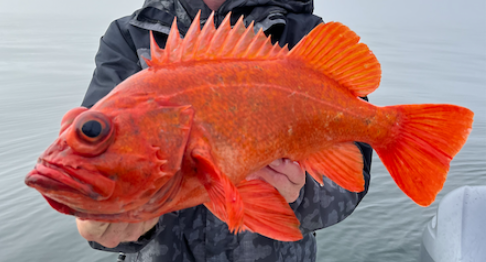BY MERIT McCREA
Fall was the beginning of the deep-water rockfish season years ago, it was a tradition. Anglers piled aboard the island-bound boats with big reels, black 6/0 Senators for the ganioneers, red 4/0s for the jig tossers. Anglers belonged to one school or the other but seldom both.
We’d leave the dock at 0200, bound for San Miguel, heading west of the island, straight out the mouth of the Santa Barbara Channel. The strategy was to angle a little high, north, of the target until we hit the 4-line on the LORAN, then follow the number southeast at 210 degrees, watching the 2-line numbers drop until you arrived on location a little after daybreak
Ganion guys would fish 80-pound Dacron in 400 feet of water, weighted down with a 2-pound sinker. Let-em-go! Soon the rod tips would be dancing as the west wind pushed us southeast, stretching the lines out off the windward side.
Then came the sound of clickers clicking as anglers wound steadily. “They’re floating!” Bloosh, bloosh, big orange blobs surrounded by bubbles out off the side indicated success.
One never knew exactly what would be on the line, giant bocaccio, huge reds, a ling, sometimes loaded with 4-pound yellowtail indicating an angler hadn’t dropped through the upper school fast enough.
It took multiple gunny sacks to hold all of a 15-fish limit some days. The jig tossers watched with distain from the bow and stern.
There they tossed 1-pound jigs downwind. A large fly above the iron was baited with whole squid.
Jiggers would take turns tossing down-wind and following their lines as they bounced bottom, a rotation of anglers working their way windward, across the bow and stern. Big lings were their prime target but they caught whatever grabbed their gear first, once again a race for the rocks through the schools of yellowtail above.
Sometimes we’d hit it huge on the deep water lings and even the ganion guys would get them, biting baits, grabbing hooked fish and hitchhiking to the top, you name it.
One day fishing west of Richardson’s Rock out on the 30-20 the lings were thick. I remember the numbers – 30.4, 18.8. First, there were doubles on 20-pound lings coming up. It was me and Rick Craddick, and I think Mike Lawton running around with gaffs, doubling up on the double hauls.
Then there was a triple, and another, and a huge tangle with lings sticking out all over. That afternoon there were two quads, double gaffs gripped bundled into a fist full. Stick one, stick another, wait for the other two to be stuck and two of us, hand over hand, two gaffs each.
The limit was 5 and we loaded the boat. That was an exceptional bite. But scores of 40 and 50 lings were pretty standard. Getting a double on lings was a stroke of luck, mostly by those fishing jig and fly with whole squids on each.
The interesting thing was it was pretty much expected that the fleet would switch over to the big gear in the fall and fish deep water, every year – even the local ¾-day runs fishing local waters.
Today the tackle has changed dramatically, all enabled by the use of the new Spectra braids pioneered by Russ Izor of Izorline. Fishing 400 to 600 feet of water with 10 to 12 ounces using a reel half the size of the old 4/0s is a breeze.
Skippers will hold the boat into the wind and anglers can fish all around the rail. The line has so little stretch it helps to put a 30-foot top-shot of monofilament just to absorb the shock of hard head shakes.
For the slow-pitch anglers fishing straight 30- to 50- pound braid on a small reel the bow of the rod does that job. A 4- or 5-ounce jig and bit of experience is all it takes to fish that gear in 500 feet of water.
Party boat anglers are fishing deep water with the same gear they used all summer. Landings no longer break out the 6/0s for their wintertime rental tackle.
The best part is how much bigger the standard deep-water rockfish is by comparison to his shallow-water brethren. When it comes to the table, few fish beat deep-water rockfish for flavor.
Merit McCrea is saltwater editor for Western Outdoor News. A veteran Southern California partyboat captain, he is a marine research scientist with the Dr. Milton Love Lab at the University of California at Santa Barbara’s Marine Science Institute. He serves on the Groundfish Advisory sub-Panel of the Pacific Fisheries Management Council, the Santa Barbara Harbor Commission, The Channel Islands National Marine Sanctuary Advisory Council and the CCA-Cal State Board. He can be reached at: merit@wonews.com.




